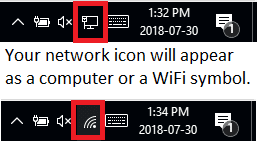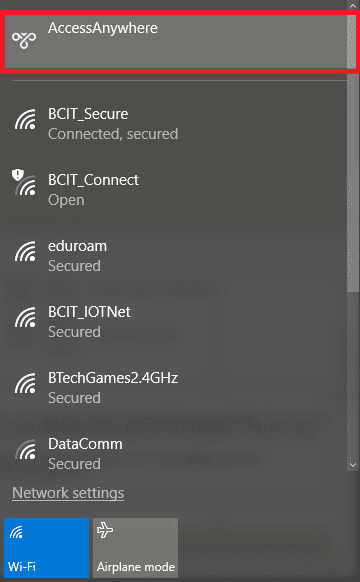myVPN
BCIT has an alternative preferrred VPN client, myVPN!
myVPN should be the first choice for students, staff, and faculty to connect to BCIT’s secure network to access common resources. There is no approval or request process needed to use myVPN. All that is required is that you are a current student, staff, or faculty at BCIT.
For most of us, this means myVPN is the best way to access BCIT resources remotely.
First Time connection for AccessAnywhere VPN on Windows 10
You will need to fill out the request form for approval before your account will have AccessAnywhere access enabled.
How to request and fill out the AccessAnywhere application.
First time setup for AccessAnywhere VPN on Windows 10
After your AccessAnywhere VPN access has been set up you can follow the instructions below to setup to AccessAnywhere VPN on your Windows 10 computer:
- Click Type here to search, and type VPN settings
- In the menu that appears, click on VPN settings
- A new window will open, in this new window click Add a VPN connection
- Configure the below options,
- VPN Provider: Windows (built-in)
- Connection name: AccessAnywhere
- Server name or address: juno.bcit.ca
- VPN type: L2TP/IPsec with pre-shared key
- Pre-shared key: bcit-vpn
- Type of sign-in info: User name and password
- User name (optional): your BCIT email prefix (everything before the @bcit.ca)
- For example: If your primary BCIT email address were “gfamily28@bcit.ca”, your BCIT email prefix would be “gfamily28”. If your primary BCIT email address were “John_Doe@bcit.ca”, your BCIT email prefix would be “John_Doe”.
- Password (optional): Your regular BCIT password
- Remember my sign-in info option should be checked
- Click save
Connecting to AccessAnywhere VPN
Once the above steps are completed you will be able to connect to AccessAnywhere VPN anytime using the below steps:
- In the bottom right corner of your Taskbar, click on the Wireless or Wired network symbol

- Click AccessAnywhere

- Click Connect
Known issues
Can connect to AccessAnywhere VPN but cannot access any bcit.ca sites
Ensure that the User name entered in the setup steps is only your BCIT email prefix (everything before the @bcit.ca). The username must not have @bcit.ca in it in order for the connection to work properly.
Restarting applications
Some applications may not function properly if you keep them open while connecting to AccessAnywhere. There have been reports that this happens to Cognos. Be sure to close applications before connecting to AccessAnywhere and restart them after AccessAnywhere has connected.